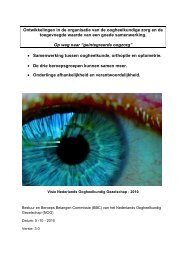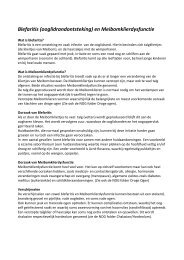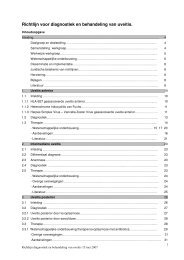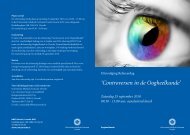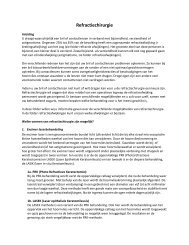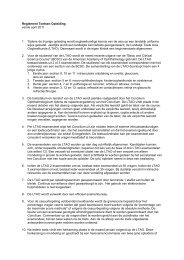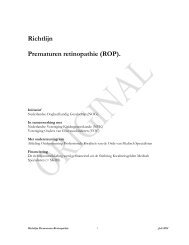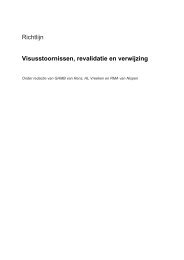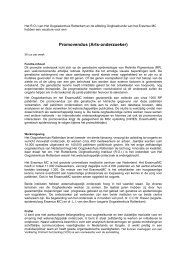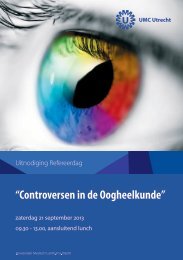terminology and guidelines for glaucoma ii - Kwaliteitskoepel
terminology and guidelines for glaucoma ii - Kwaliteitskoepel
terminology and guidelines for glaucoma ii - Kwaliteitskoepel
You also want an ePaper? Increase the reach of your titles
YUMPU automatically turns print PDFs into web optimized ePapers that Google loves.
3.3.2.3 - Category: PROSTAGLANDINS AND ADRENERGIC ANTAGONISTS<br />
Prostagl<strong>and</strong>in & ß-Blocker<br />
Generics<br />
Latanoprost 0.005% <strong>and</strong> Timolol 0.5%<br />
Tradenames<br />
Xalcom, Xalacom<br />
Action<br />
In latanoprost the most evident action is the increase of the uveo-scleral outflow, reducing IOP 20% - 35%. Timolol<br />
decreases intraocular pressure by reduction of the aqueous humor production. Peak effect in 2 hrs. <strong>for</strong> timolol <strong>and</strong> 8-12<br />
hours <strong>for</strong> latanoprost.<br />
Dosage <strong>and</strong> administration<br />
Starting dose is one drop in the morning.<br />
Indications<br />
Elevation of intraocular pressure in patients where the IOP can be deleterious <strong>for</strong> the preservation of visual function in<br />
spite of medical <strong>glaucoma</strong> monotherapy.<br />
Major Contraindications<br />
Non-selective β-blockers: Asthma, history of obstructive pulmonary disease, sinus bradycardia (< 60 beats/min), heart<br />
block, or cardiac failure<br />
Known hypersensitivity to latanoprost, timolol, benzalkonium chloride, or any other product ingredient.<br />
Patients should not administer these drugs while wearing contact lenses, but contact lenses can be reinserted 15 minutes<br />
following administration of the drugs.<br />
Major side effects<br />
Systemic:<br />
Ocular:<br />
Bradycardia, arrhythmia, heart failure, syncope, bronchospasm, <strong>and</strong> airways obstruction. Distal edema,<br />
hypotension. Depression. Hypoglycemia may be masked in insulin dependent diabetes mellitus. Betablocking<br />
agents are associated with nocturnal hypotension, which may be a risk factor in progression of<br />
<strong>glaucoma</strong>tous optic nerve damage.<br />
Conjunctival hyperemia, burning <strong>and</strong> stinging, <strong>for</strong>eign body sensation <strong>and</strong> itching.<br />
Eyelash changes (increased length, thickness, pigmentation, <strong>and</strong> number of lashes).<br />
Increased iris pigmentation in patients treated with melanocytes is increased. Especially seen in patients<br />
with green-brown, blue/gray-brown or yellow-brown irides. The long-term effects on the melanocytes <strong>and</strong><br />
the consequences of potential injury to the melanocytes <strong>and</strong> /or deposition of pigment granules to other<br />
areas of the eye are currently unknown. The effect may be permanent.<br />
Cystoid macular edema in aphakes/pseudophakes has been reported in few cases, most occurring in<br />
aphakic patients, in pseudophakic patients with a posterior lens capsule rupture, or in patients with known<br />
risk factors <strong>for</strong> macular edema.<br />
Epithelial keratopathy, slight reduction in corneal sensitivity.<br />
Reactivation of herpes keratitis.<br />
Anterior uveitis.<br />
Precautions<br />
Cystoid macular edema in aphakes/pseudophakes has been reported in few cases, most occurring in aphakic patients, in<br />
pseudophakic patients with a posterior lens capsule rupture, or in patients with known risk factors <strong>for</strong> macular edema.<br />
Unilateral treatment may cause a difference in iris colour between the eyes.<br />
Patients with uveitis.<br />
Ch. 3 - 25 EGS



